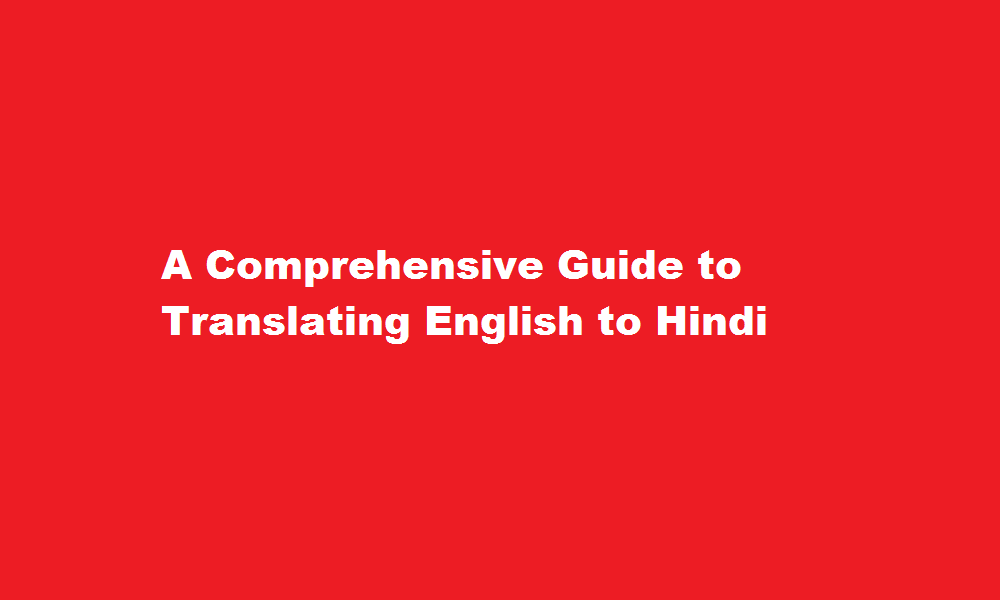A Comprehensive Guide to Translating English to Hindi
3 min read
Introduction
Translation is an essential skill in today’s globalized world, connecting people from different cultures and languages. Hindi, as one of the widely spoken languages, plays a significant role in bridging communication gaps. This article aims to provide a comprehensive guide on how to translate English to Hindi effectively. We will explore various techniques, resources, and tips to ensure accurate and culturally appropriate translations.
Understanding the Basics
Before diving into the translation process, it is essential to grasp the fundamentals of both English and Hindi languages. English follows a subject-verb-object (SVO) sentence structure, while Hindi typically follows a subject-object-verb (SOV) pattern. Familiarizing yourself with the grammar rules, vocabulary, and idiomatic expressions in both languages will help you produce accurate translations.
Transliteration vs. Translation
Transliteration is the process of writing words from one script to another without changing their meaning. Hindi, being a language written in the Devanagari script, often requires transliteration when dealing with proper nouns or technical terms. However, for a comprehensive translation, it is crucial to go beyond transliteration and capture the true essence of the message. This involves understanding the context, cultural nuances, and idiomatic expressions to ensure an accurate translation.
Useful Online Tools and Resources
In today’s digital age, numerous online tools and resources are available to aid in English to Hindi translation. Websites like Google Translate, Microsoft Translator, and Translate.com offer instant translations, although their accuracy may vary. These tools can be useful for quick reference, but they should not be solely relied upon for professional or high-quality translations.
Dictionaries and Translation Apps
Using dictionaries and translation apps specifically designed for English to Hindi translations can greatly assist in the process. Renowned dictionaries like Oxford Hindi-English Dictionary and Shabdkosh provide comprehensive word meanings, synonyms, and contextual usage. Popular translation apps such as Hindi English Translator and Hinkhoj also offer reliable translations, along with voice input and pronunciation assistance.
Cultural Sensitivity and Context
Language is deeply intertwined with culture, and translations must reflect the cultural nuances of the target language. Hindi, being rich in idiomatic expressions and cultural references, requires careful consideration of context. Understanding the cultural background and customs of the Hindi-speaking audience is vital to ensure accurate and appropriate translations. Avoiding literal translations and opting for contextually relevant equivalents will enhance the quality and impact of your translations.
Proofreading and Editing
Once the initial translation is complete, it is crucial to proofread and edit the text thoroughly. This step helps identify any errors, inconsistencies, or inaccuracies in the translation. Seek feedback from native Hindi speakers or professional translators to ensure the quality and accuracy of the final translated document.
FREQUENTLY ASKED QUESTIONS
Which is the most accurate translator for Hindi?
Arguably the most popular platform for translation – not just for Hindi to English and vice versa. Google Translate supports over 100 languages, including Spanish, French, Bengali, and Chinese. The platform is completely free to use and offers translation in real time.
Which translator is better than Google?
DeepL Translate: The world’s most accurate translator.
Do translators use Google?
One of the common misconceptions about translation service providers is they use Google Translate to do their work. But do they really do that? The answer is NO. They may use it as a research tool to check for words or phrases that they are unsure about.
Conclusion
Translating English to Hindi requires a combination of linguistic skills, cultural awareness, and thorough research. By understanding the nuances of both languages and utilizing the available tools and resources effectively, you can produce accurate and culturally appropriate translations that effectively convey the intended message.
Read Also : Efficient Stock Management in Tally A Comprehensive Guide






